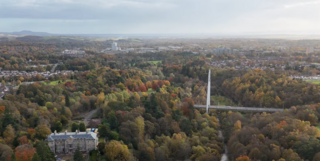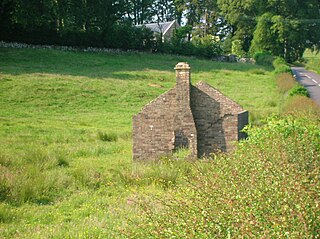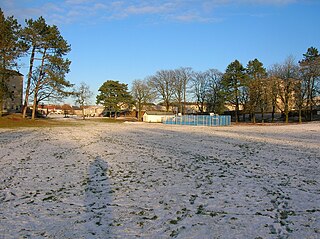
Curling is a sport in which players slide stones on a sheet of ice toward a target area which is segmented into four concentric circles. It is related to bowls, boules and shuffleboard. Two teams, each with four players, take turns sliding heavy, polished granite stones, also called rocks, across the ice curling sheet toward the house, a circular target marked on the ice. Each team has eight stones, with each player throwing two. The purpose is to accumulate the highest score for a game; points are scored for the stones resting closest to the centre of the house at the conclusion of each end, which is completed when both teams have thrown all of their stones once. A game usually consists of eight or ten ends.

Glenrothes is a town situated in the heart of Fife, in east-central Scotland. It had a population of 39,277 in the 2011 census, making it the third largest settlement in Fife and the 18th most populous locality in Scotland. Glenrothes is the administrative capital of Fife, containing the headquarters of both Fife Council and Police Scotland Fife Division and is a major service centre within the area.

Stephenville is a town in Newfoundland and Labrador, Canada, on the west coast of the island of Newfoundland.

An ice rink is a frozen body of water and/or an artificial sheet of ice where people can ice skate or play winter sports. Ice rinks are also used for exhibitions, contests and ice shows. The growth and increasing popularity of ice skating during the 1800s marked a rise in the deliberate construction of ice rinks in numerous areas of the world.

The Ottawa Curling Club is an historic curling club located on O'Connor Street in the Centretown neighbourhood of Ottawa, Ontario, Canada. It is the oldest curling club in Ottawa, established in 1851 by Allan Gilmour as the Bytown Curling Club. The Club first played on the Rideau Canal until 1858. It subsequently moved to different locations around the city until finally settling at its current location on O'Connor in 1916. In 1931 the club was expanded to the current capacity of 5 curling sheets. Artificial ice was also installed at that time.
A bonspiel is a curling tournament, consisting of several games, often held on a weekend. Until the 20th century most bonspiels were held outdoors, on a frozen freshwater loch. Today almost all bonspiels are held indoors on specially prepared artificial ice.

Balfarg is a prehistoric monument complex in Glenrothes, Fife, Scotland. It is protected as a scheduled monument. With the development of Glenrothes new town in the latter half of the 20th Century an adjacent residential area was developed around the complex carrying the same name.

The Royal Caledonian Curling Club (RCCC), branded as Scottish Curling is a curling club in Edinburgh, Scotland. It developed the first official rules for the sport, and is the governing body of curling in Scotland. The RCCC was founded on 25 July 1838 in Edinburgh, and granted its royal charter by Queen Victoria in 1843, after she had witnessed a demonstration of the sport played on the polished ballroom floor of Scone Palace the previous year.

CurlON is the governing body of curling in Southern Ontario. Northern Ontario is governed by the Northern Ontario Curling Association (NOCA). The CurlON sends a team to represent Team Ontario at all major Canadian Championships. The NOCA sends a separate team to all of these events.

Markinch (, is both a village and a parish in the heart of Fife, Scotland. According to an estimate taken in 2008, the village has a population of 2,420. The civil parish had a population of 16,530. Markinch is east of Fife's administrative centre, Glenrothes and preceded Cupar as Fife's place of warranty and justice prior to the 13th century.
Evenie Water Curling Club was formed in 1872 and has been active in Angus curling circles ever since. The original curling pond is on the estate of Middleton of Gardyne close to the village of Friockheim, Scotland. The club currently curls at Forfar ice rink and the club is a member of the Royal Caledonian Curling Club and actively compete in RCCC competitions.
The San Francisco Bay Area Curling Club (SFBACC) is a non-profit corporation serving the needs for the play and development of the sport of curling in the San Francisco Bay Area and its surrounding outskirts. Headquartered in Oakland, California, it is the largest curling club in California as well as in the Mountain Pacific Curling Association.

A curling house was used to store curling stones, brushes and other equipment used to maintain a curling pond and play the game of curling in Scotland and elsewhere.
Thomas Brewster Jr. is a Scottish curler from Aberdeen, Scotland. He is currently the coach of the Ross Paterson men's team.

New Farm Loch was situated in a low-lying area between the farms of Holehouse and New Farm in the Parish of Kilmarnock, New Farm Loch, East Ayrshire in Scotland. The loch was mostly artificial, having been developed as a curling pond, fed by the Hillhouse Burn through seasonal flooding. The loch was drained via Holehouse Farm Burn.
The Potomac Curling Club is a curling club started in 1961 and currently curling in Laurel, Maryland. Operating out of the National Capital Curling Center, a dedicated curling ice facility at The Gardens Ice House operated under a long-term lease since 2002, the group maintains four sheets of dedicated curling ice, the only dedicated curling ice in the Washington, D.C., area. The club operates during the main curling season, although social events for the membership occur during the summer.
Palgrave Pond is a reservoir just northwest of the community of Palgrave in the Town of Caledon, Regional Municipality of Peel in the Greater Toronto Area of southern Ontario, Canada. It is adjacent to Ontario Highway 50 and was formed by the damming of the main branch of the Humber River, originally to create a mill pond. Each winter, the surface of the pond is transformed into a community skating rink available for recreational use. The rinks are created by local volunteer, Ken Hunt, and have appeared on the Mill Pond each winter since December 2000.

The Dalgety Bay Curling Club is a social curling club based in Dalgety Bay, Fife, Scotland. The club plays its games at the Kinross Curling Rink in Kinross and the Edinburgh Curling Club, part of the Murrayfield Ice Rink next to Murrayfield Stadium.

The Kitchener-Waterloo Granite Curling Club is a curling club on Seagram Drive in Waterloo, Ontario.













